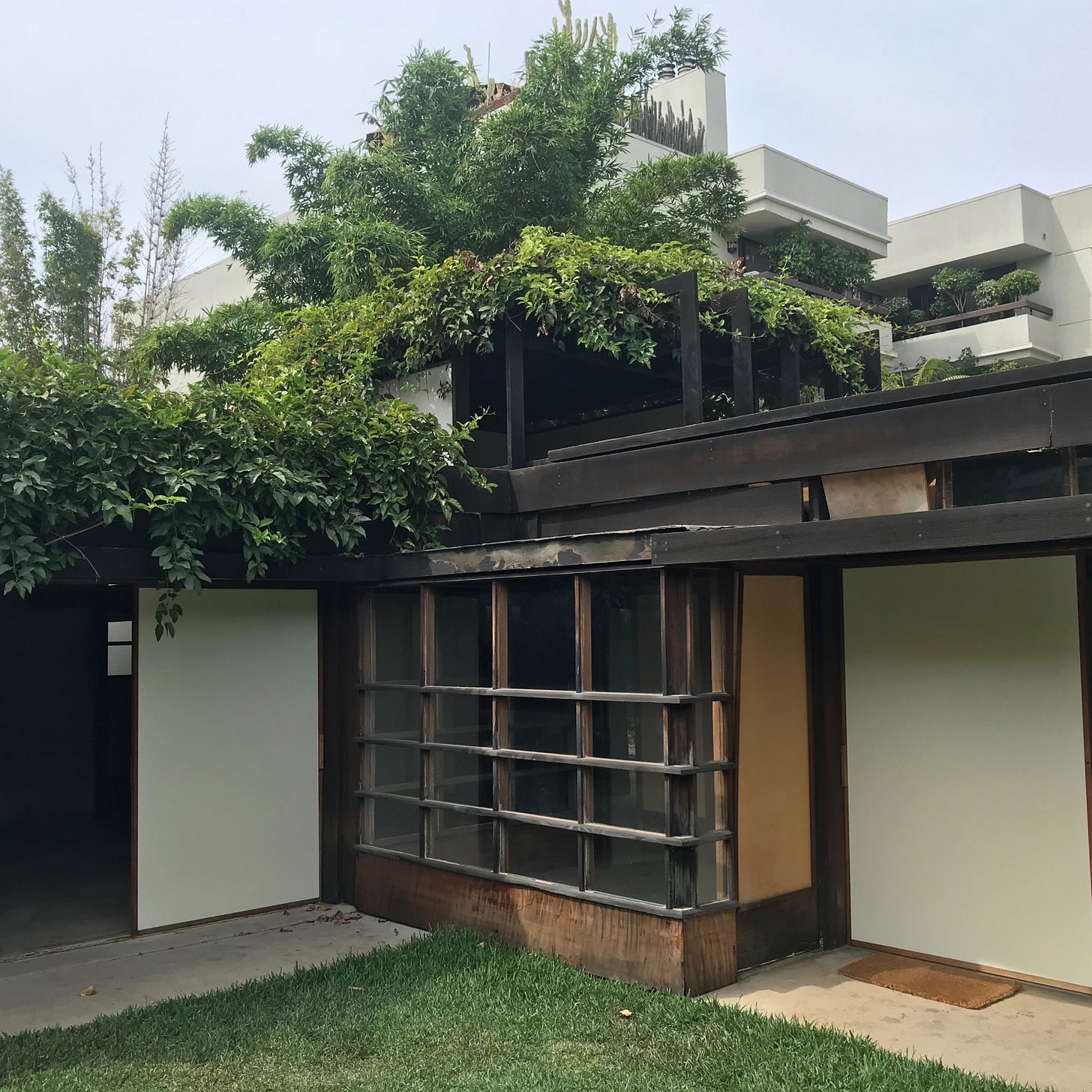Magical Sleeping Spaces
I visited the Schindler House in West Hollywood and became fixated on an unusual architectural feature.
What if I told you I knew of a place in the middle of a noisy city that felt far away from it all? A place hidden safely behind a curtain of bamboo, so quiet that the only sound you can hear is the rustling of nearby trees – sounds like a place born from a magic spell, right?
I’d call it the Los Angeles Rift, only calling it a rift implies that it formed a crack in the city when in reality, the city built itself around it.
The place I’m talking about is the Schindler House, a beautiful piece of architecture designed by Rudolph Schindler in West Hollywood in 1922.

My photo taken in Schindler House’s backyard.
No, he’s not that Schindler. Rudolph Schindler was an Austrian-American architect who helped popularize mid-century modern houses in Los Angeles. While he designed a number of unconventional homes and buildings throughout his life, the Schindler House is the first home ever to be build in the modernist style, and many admirers consider it to be his finest work.
What makes the Schindler House more intriguing than his other projects is that Rudolph built the home as a communal living space for him and his wife, Pauline, and another couple. Imagine this kind of living situation in 1922: two couples together with no designated living room – just four rooms to divide up and a shared kitchen and bath.

The Schindler House floor plan, courtesy of the United States Library of Congress.
An odd kind of place for an odd kind of couple at the time: the Schindlers eventually divorced, but after the other couple moved out, Pauline moved to the other side of the house, and the two continued to live together until Rudolph died in 1953.
Today, the Schindler House is open to visitors and is run by a nonprofit, the MAK Center for Art and Architecture. I visited with a friend this weekend and knew I would enjoy it, since I appreciate thoughtfully-designed things.
For one, it’s clear that Rudolph was influenced by Japanese design. The sliding doors and walls separating the rooms resemble shoji screens. The numerous, gigantic windows allow for no person to pass inside without being reminded they are surrounded by nature. I spent a lot of time in one particular room, plotting my desk setup as if I was going to move in next week.

Me, thinking about the amount of work I could get done if I had a desk looking out into this backyard.
There was balance in everything. All the doors were open, allowing for visitors to step in and out with ease – private and public. The cold concrete walls were set against wooden beams and glass (so much glass!) The compact structure of the house contrasted with the unruly trees dusting the roofs.
And the ROOFS. Let’s talk about these roofs. While Rudolph was influenced by Japanese design, above all else, the Schindler House is a Modern Southern California home. Rudolph began the design process after a trip he and Pauline took to Yosemite, and he had camping on the brain.
So, Rudolph built sleeping porches on the roof of each of the two apartments. Who said sleeping under the stars was an activity reserved for camping? The man was ahead of his time.

One of the sleeping porches is on this roof.
I was obsessed. Imagine late summer nights spent on that roof, back when there wasn’t air or light pollution, and you could blink up at the sky and see the cosmos. I couldn’t stop thinking about the roofs for the rest of the day.
Childhood Sleeping Spaces
The roofs remind me of my cousins’ old house in Long Beach. I spent my childhood at the house, having sleepovers and climbing the big tree in the backyard, but the strongest memory I have is of my oldest cousin’s secret spot on the patio beams.
These wooden beams would stand over the backyard patio, and during moments when the little kids (myself included) were especially annoying, or when she wanted time alone to read a chapter book, my cousin would climb out her window onto the beams and shimmy over. And she'd just hang out there. Sometimes she’d fall asleep.
The most magical place I’ve slept in so far is the penguin encounter exhibit at SeaWorld. This one:

Did you know that SeaWorld offers overnighters for youth groups? It’s probably the most moral thing they can do, besides closing their operations and freeing their imprisoned animals.
I spent the night in the exhibit with with my Girl Scout troop when I was 10, and I didn’t sleep at all. How could I, when there were penguins waddling and diving and sliding on their bellies all around me?!
There were dozens of Girl Scout troops inside. We laid out our sleeping bags, fighting over who was going to sleep next to who, played card games, and chatted quietly, but for me, the real magic began after everyone fell asleep.
The lights were off, but the exhibit on the other side of the glass glowed dimly like a nightlight. Most of the penguins slept standing up, their necks bent to their sides, but a few were up and about, like me. I sat in my sleeping bag and pressed my forehead to the glass, watching.
Let me tell you, there are few experiences more magical as a 10 year-old than watching penguins walk around in the middle of the night while you’re sleep-deprived on the verge of delirium.
Secret Spaces in Children’s Literature
So many children’s fantasies involve secret sleeping spaces. Think about the books you read as a kid. Some of the books I cherished most growing up featured whimsical homes and places to sleep that weren’t actual beds.
One example is The Boxcar Children franchise. The 1924 tale follows four orphaned siblings after the death of their parents. Fearing living with a grandfather they don’t know, the siblings run away and find an abandoned boxcar to live out of. The oldest brother works odd jobs in town to earn money for food, and all the kids work hard to maintain their independence and turn the boxcar into a real home.
They fashion beds out of pine needles. They adopt an injured stray dog they find. They have a “nightcap” every night, which is just water they drink out of milk bottles. They’re happy.
Eventually they meet their grandfather and, surprise! He’s cool. The Boxcar Children move into his house and go on to solve mysteries à la Nancy Drew, but I remain convinced that those kids were happiest when they were living out of the boxcar.

Another example of an imaginative home I loved is the “home under the ground” in Peter Pan that Peter and his Lost Boys live in.
Some of the perks of living under the ground, according to the book: you can dig for earthworms to use for fishing, a bunch of mushrooms serve as sitting stools, and there’s a giant fireplace to warm the whole room. Tinker Bell, of course, gets her own apartment, which is outrageously excessive – her couch, for example, is a “genuine Queen Mab, with club legs; and she varied the bedspreads according to what fruit-blossom was in season.”

But my favorite part about this underground home was learning that all the Lost Boys entered it via their own tree. Chapter 7 details the process at length:
One of the first things Peter did next day was to measure Wendy and John and Michael for hollow trees.
Hook, you remember, had sneered at the boys for thinking they needed a tree apiece, but this was ignorance, for unless your tree fitted you it was difficult to go up and down, and no two of the boys were quite the same size.
Once you fitted, you drew in [let out] your breath at the top, and down you went at exactly the right speed, while to ascend you drew in and let out alternately, and so wriggled up. Of course, when you have mastered the action you are able to do these things without thinking of them, and nothing can be more graceful.
They each essentially access the home by riding down their own customized slide! If there’s anything cooler than reading about a sword fight scene, it’s this.
A final beloved children’s book that talks about a special sleeping nook is Anne of Green Gables.
Anne Shirley, the book’s heroine, is an orphan girl with a beautiful imagination. In the beginning of the story, it’s clear that Anne’s imagination has helped her to endure the trauma of her parents’ deaths and her time in the orphanage. When she’s picked up at the train station by her adopted parent, Matthew, who comes a bit late, she launches into a monologue.
I’m very glad to see you. I was beginning to be afraid you weren’t coming for me and I was imagining all the things that might have happened to prevent you.
I had made up my mind that if you didn’t come for me to-night I’d go down the track to that big wild cherry-tree at the bend, and climb up into it to stay all night. I wouldn’t be a bit afraid, and it would be lovely to sleep in a wild cherry-tree all white with bloom in the moonshine, don’t you think? You could imagine you were dwelling in marble halls, couldn’t you?
Anne finds beauty in everything she sees, and because she has so little, she’s able to appreciate the little things. She fantasizes about sleeping in a wild cherry-tree, and it’s easy for her to pretend she’s in a grand palace. What she’s really dreaming about is having a place to call home.

For me, special sleeping spaces are special because they offer an exciting change from the bed I usually sleep in every night. And with a change as small as this, more opportunities arise for me to dream about all the other things that are possible.
If you allow yourself to sleep beneath the stars every once in a while, imagine what other things you can bring yourself to try.


